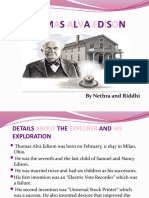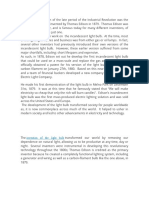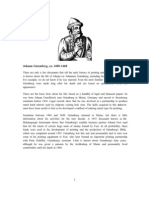Thomas Alva Edison
Thomas Alva Edison
Uploaded by
Galo GutiérrezCopyright:
Available Formats
Thomas Alva Edison
Thomas Alva Edison
Uploaded by
Galo GutiérrezCopyright
Available Formats
Share this document
Did you find this document useful?
Is this content inappropriate?
Copyright:
Available Formats
Thomas Alva Edison
Thomas Alva Edison
Uploaded by
Galo GutiérrezCopyright:
Available Formats
Thomas Alva Edison
Thomas Alva Edison (February 11, 1847 – October 18, 1931) was an American inventor and
businessman, who has been described as America's greatest inventor. He developed many
devices that greatly influenced life around the world, including the phonograph, the motion
picture camera, and the long-lasting, practical electric light bulb. Dubbed "The Wizard of
Menlo Park", he was one of the first inventors to apply the principles of mass production and
large-scale teamwork to the process of invention, and is often credited with the creation of the
first industrial research laboratory.
Edison was a prolific inventor, holding 1,093 US patents in his name, as well as many patents
in the United Kingdom, France, and Germany. More significant than the number of Edison's
patents was the widespread impact of his inventions: electric lightand power utilities, sound
recording, and motion pictures all established major new industries worldwide. Edison's
inventions contributed to mass communication and, in particular, telecommunications. These
included a stock ticker, a mechanical vote recorder, a battery for an electric car, electrical
power, recorded music and motion pictures. His advanced work in these fields was an
outgrowth of his early career as a telegraph operator. Edison developed a system of electric-
power generation and distribution to homes, businesses, and factories – a crucial development
in the modern industrialized world. His first power station was on Pearl Street in Manhattan,
New York.
Incandescent light bulb
In addressing the question of who invented the incandescent lamp, historians Robert Friedel
and Paul Israel list 22 inventors of incandescent lamps prior to Joseph Swanand Thomas
Edison. They conclude that Edison's version was able to outstrip the others because of a
combination of three factors: an effective incandescent material, a higher vacuum than others
were able to achieve (by use of the Sprengel pump) and a high resistance that made power
distribution from a centralized source economically viable.
Historian Thomas Hughes has attributed Edison's success to his development of an entire,
integrated system of electric lighting.
The lamp was a small component in his system of electric lighting, and no more critical to its
effective functioning than the Edison Jumbo generator, the Edison main and feeder, and the
parallel-distribution system. Other inventors with generators and incandescent lamps, and
with comparable ingenuity and excellence, have long been forgotten because their creators did
not preside over their introduction in a system of lighting.
You might also like
- Excerpt: "The Age of Edison: Electric Light and The Invention of Modern America" by Ernest FreebergDocument10 pagesExcerpt: "The Age of Edison: Electric Light and The Invention of Modern America" by Ernest Freebergwamu8850No ratings yet
- The Last Days of NightDocument6 pagesThe Last Days of Nightwamu88567% (3)
- Biography of Thomas Alva EdisonDocument5 pagesBiography of Thomas Alva EdisonAde HerdianaNo ratings yet
- Timeless Thomas: How Thomas Edison Changed Our LivesFrom EverandTimeless Thomas: How Thomas Edison Changed Our LivesRating: 4 out of 5 stars4/5 (18)
- Manalo, Cristian James P. November 07, 2020 BSA 2-11 SawsaDocument5 pagesManalo, Cristian James P. November 07, 2020 BSA 2-11 SawsaCristian James ManaloNo ratings yet
- Thomas Edison - WikipediaDocument24 pagesThomas Edison - Wikipediaismaeel247No ratings yet
- Thomas Alva EdisonDocument2 pagesThomas Alva Edisonmansoorahmed86No ratings yet
- Thomas Alva EdisonDocument1 pageThomas Alva EdisonMuhammed BasheerNo ratings yet
- Assgt1 Idakusuma InventorDocument3 pagesAssgt1 Idakusuma Inventorai_eiNo ratings yet
- EdisonDocument1 pageEdisonRev Andrew SalinasNo ratings yet
- Thomas Alva EdisonDocument6 pagesThomas Alva EdisonViani OsorioNo ratings yet
- Thomas EdisonDocument6 pagesThomas Edisonrenuk4156No ratings yet
- Thomas Alva EdisonDocument1 pageThomas Alva EdisonJoshua KikushimaNo ratings yet
- Tema EnglezaDocument1 pageTema EnglezaAndrei FloricicaNo ratings yet
- Biografi Thomas Alva EdisonDocument2 pagesBiografi Thomas Alva EdisonXel InspirasimuNo ratings yet
- Thomas Alva Edison (February 11, 1847 - October 18, 1931) WasDocument5 pagesThomas Alva Edison (February 11, 1847 - October 18, 1931) WasAbdullah HamidNo ratings yet
- Thomas Alva EdisonDocument1 pageThomas Alva EdisonteddyarguelloNo ratings yet
- Thomas Alva EdisondosDocument4 pagesThomas Alva EdisondosdonblasNo ratings yet
- Thomas Alva EdisonDocument1 pageThomas Alva EdisonvijaysairamNo ratings yet
- Edison's LightbulbDocument3 pagesEdison's LightbulbAxyle NoqueraNo ratings yet
- Name: Hernández Díaz Valeria F. Intermediate 5: Thomas Alva EdisonDocument1 pageName: Hernández Díaz Valeria F. Intermediate 5: Thomas Alva EdisonMiriam NavaNo ratings yet
- Thomas Edison Research PaperDocument7 pagesThomas Edison Research PaperlilmissswaggaajNo ratings yet
- Ingles 4 S04Document4 pagesIngles 4 S04Kevin Torres ColanNo ratings yet
- Homas Alva Edison: Early LifeDocument3 pagesHomas Alva Edison: Early LifeVishal DhekaleNo ratings yet
- Thomas EdisonDocument3 pagesThomas EdisonTerencio HueteNo ratings yet
- Final Thomas Alva EdsionDocument13 pagesFinal Thomas Alva Edsion19nethranNo ratings yet
- The History of The Motion PictureDocument5 pagesThe History of The Motion PictureRaj Kishor SinghNo ratings yet
- Soc124 Thomas EdisonDocument8 pagesSoc124 Thomas EdisonKaren VillaruelNo ratings yet
- Thomas Edison Was Born in MilanDocument20 pagesThomas Edison Was Born in MilanRamesh RamamoorthyNo ratings yet
- Visual StoryDocument2 pagesVisual Storyzui29012007No ratings yet
- Light BulbDocument1 pageLight BulbNaomi HernandezNo ratings yet
- Reading Comprehension Worksheet Thomas EdisonDocument2 pagesReading Comprehension Worksheet Thomas EdisonGhina Itani100% (1)
- No Highlighter FinalDocument10 pagesNo Highlighter Finalapi-223800220No ratings yet
- Thomas Alva EdisonDocument1 pageThomas Alva EdisonGanesh KumarNo ratings yet
- Thomas Edinson: Giankarlo Jimenez Ojeda Sebastian PazDocument7 pagesThomas Edinson: Giankarlo Jimenez Ojeda Sebastian PazGiankarlo JimenezNo ratings yet
- PC2 - 2017-1 - AntenasDocument7 pagesPC2 - 2017-1 - Antenaspedro7127 pedro7127No ratings yet
- Thomas EdisonDocument5 pagesThomas EdisonCarlo Fernando PadinNo ratings yet
- Thomas Edison: Created by Tomas Ragauskas and Eidvilė Ažusienytė 2cDocument14 pagesThomas Edison: Created by Tomas Ragauskas and Eidvilė Ažusienytė 2cTomas RagauskasNo ratings yet
- Thomas EdisonDocument10 pagesThomas Edisonامين amineNo ratings yet
- Dara Sofia... Eim Vii-TemperanceDocument4 pagesDara Sofia... Eim Vii-TemperancenicahNo ratings yet
- R Group 4 Thomas EdisonDocument5 pagesR Group 4 Thomas EdisonAriel YedidjaNo ratings yet
- Thomas Alva EdisonDocument3 pagesThomas Alva EdisonUmesh PremaniNo ratings yet
- Carbon TelephoneDocument2 pagesCarbon Telephonejacobges42No ratings yet
- Unit 5 - ArticleDocument1 pageUnit 5 - ArticlePhương Anh NguyễnNo ratings yet
- Thomas EdisonDocument20 pagesThomas EdisonEmmanuel C. PradoNo ratings yet
- XDIAK SƏRBƏST İşDocument20 pagesXDIAK SƏRBƏST İşSukur BagirovNo ratings yet
- 1 Introduction To Industrial ElectronicsDocument29 pages1 Introduction To Industrial ElectronicsScribdTranslationsNo ratings yet
- Thomas Alva Edison: Source: Https://edison - Rutgers.edu/biogrphy - HTM, Last Updated: October 28, 2016Document5 pagesThomas Alva Edison: Source: Https://edison - Rutgers.edu/biogrphy - HTM, Last Updated: October 28, 2016Id TumbalNo ratings yet
- Thomas EdisonDocument2 pagesThomas EdisonCarlo Fernando Padin100% (1)
- 12 Innovation That Change The WorldDocument11 pages12 Innovation That Change The Worldsachin2007jainNo ratings yet
- Johann GutenbergDocument7 pagesJohann GutenbergsaifulkamalabduljaliNo ratings yet
- Thomas Alva Edison: (Invention of The Light Bulb)Document4 pagesThomas Alva Edison: (Invention of The Light Bulb)nurqasseh1991No ratings yet
- Ensayo Sobre Thomas EdisonDocument6 pagesEnsayo Sobre Thomas Edisoncjaxdk5h100% (1)
- Thomas Edison: Sir Isaac Newton'sDocument3 pagesThomas Edison: Sir Isaac Newton'sMuzammil ShaikhNo ratings yet
- Light BulbDocument13 pagesLight BulbFurious ZouhairNo ratings yet
- The Greatest Inventor in HistoryDocument1 pageThe Greatest Inventor in HistoryHuarachi Donaire Limber JhonatanNo ratings yet
- Electricity ProblemsDocument6 pagesElectricity Problemselrojo2002No ratings yet
- 10Document1 page10LucasNo ratings yet
- Tesla and EdisonDocument2 pagesTesla and EdisonmariamclarityatruthNo ratings yet
- Tomas Edison BioDocument1 pageTomas Edison BioAna KowalskaNo ratings yet
- Lesson Plan Ten MathDocument2 pagesLesson Plan Ten Mathapi-300889911No ratings yet
- EST Brochure JordanDocument2 pagesEST Brochure JordanMahmood ShanaahNo ratings yet
- JAVA 8 FeaturesDocument34 pagesJAVA 8 FeaturesGaurav PathakNo ratings yet
- Controls For Differentiated Strategies - TunishaDocument21 pagesControls For Differentiated Strategies - TunishaTunisha JethwaniNo ratings yet
- Lesson Worksheet: 6.1A MeanDocument7 pagesLesson Worksheet: 6.1A Meanwaiman fuNo ratings yet
- Chapter 8. Software PrototypingDocument2 pagesChapter 8. Software PrototypingRijoy MukherjeeNo ratings yet
- Power 1 Chapter-6 PDFDocument29 pagesPower 1 Chapter-6 PDFEnyew100% (1)
- 23UHV02-UHV SYLLABUS AND NOTESDocument77 pages23UHV02-UHV SYLLABUS AND NOTESmanjunadhasompalleNo ratings yet
- Direct & Indirect ProofsDocument2 pagesDirect & Indirect ProofsHazem ModaNo ratings yet
- 16-10-2022 - Jr.C-120 - Jee-Adv (2019-P2) - WTA-11 - Key & Sol'sDocument8 pages16-10-2022 - Jr.C-120 - Jee-Adv (2019-P2) - WTA-11 - Key & Sol'sBhavya PNo ratings yet
- The Mysterious Island by Verne, Jules, 1828-1905Document316 pagesThe Mysterious Island by Verne, Jules, 1828-1905Gutenberg.org100% (1)
- Real NumbersDocument57 pagesReal Numberssujaritha sureshNo ratings yet
- The One Per CentDocument4 pagesThe One Per CentEliot FintushelNo ratings yet
- Alexander The Great A Reader - (12 Alexander The Great')Document20 pagesAlexander The Great A Reader - (12 Alexander The Great')Jordan WheelerNo ratings yet
- TLE 7-PlanDocument19 pagesTLE 7-PlanMaryjane JulveNo ratings yet
- Mi Barrio - QuizletDocument11 pagesMi Barrio - Quizletkomalds88No ratings yet
- The Princess and The Packet of Frozen Peas Original DraftDocument5 pagesThe Princess and The Packet of Frozen Peas Original DraftTony Wilson100% (1)
- Dr. Mukund S. WasekarDocument12 pagesDr. Mukund S. Wasekarpatilvr3578No ratings yet
- Airtel Payment BankDocument2 pagesAirtel Payment BankGanesh Tiwari100% (1)
- The Shia Identity Persecution Horizons Victims of Terrorism and Extremism 1st Edition Riyadh Al-Hakim download pdfDocument45 pagesThe Shia Identity Persecution Horizons Victims of Terrorism and Extremism 1st Edition Riyadh Al-Hakim download pdfmanyexignara100% (1)
- Radiator - MountingDocument3 pagesRadiator - MountingJESUSNo ratings yet
- G.R. No. 176020 Heirs of Julao v. de JesusDocument8 pagesG.R. No. 176020 Heirs of Julao v. de JesusVernis VentilacionNo ratings yet
- Topic Identification of Instagram Hashtag Sets For Image Tagging: An Empirical AssessmentDocument12 pagesTopic Identification of Instagram Hashtag Sets For Image Tagging: An Empirical Assessmentrf001No ratings yet
- Subroutines ExplanationDocument5 pagesSubroutines ExplanationKabil RockyNo ratings yet
- Here Are 25 Ways You Can Control Your Anger: Count DownDocument3 pagesHere Are 25 Ways You Can Control Your Anger: Count DownKevin Espiritu100% (1)
- Ad2 Britanico Gold RT Jun 2021Document1 pageAd2 Britanico Gold RT Jun 2021RONALDO JACINTO PEÑA VALERIONo ratings yet
- CH 1Document21 pagesCH 1Naina GargNo ratings yet
- Die_with_Zero_31052024_052149_PMDocument3 pagesDie_with_Zero_31052024_052149_PMyayicat943No ratings yet
- Imperatori Et Al (2022) - The Relationship Between Childhood Trauma Pathological Dissociation - FinalDocument2 pagesImperatori Et Al (2022) - The Relationship Between Childhood Trauma Pathological Dissociation - FinalzuveriaNo ratings yet

























































































